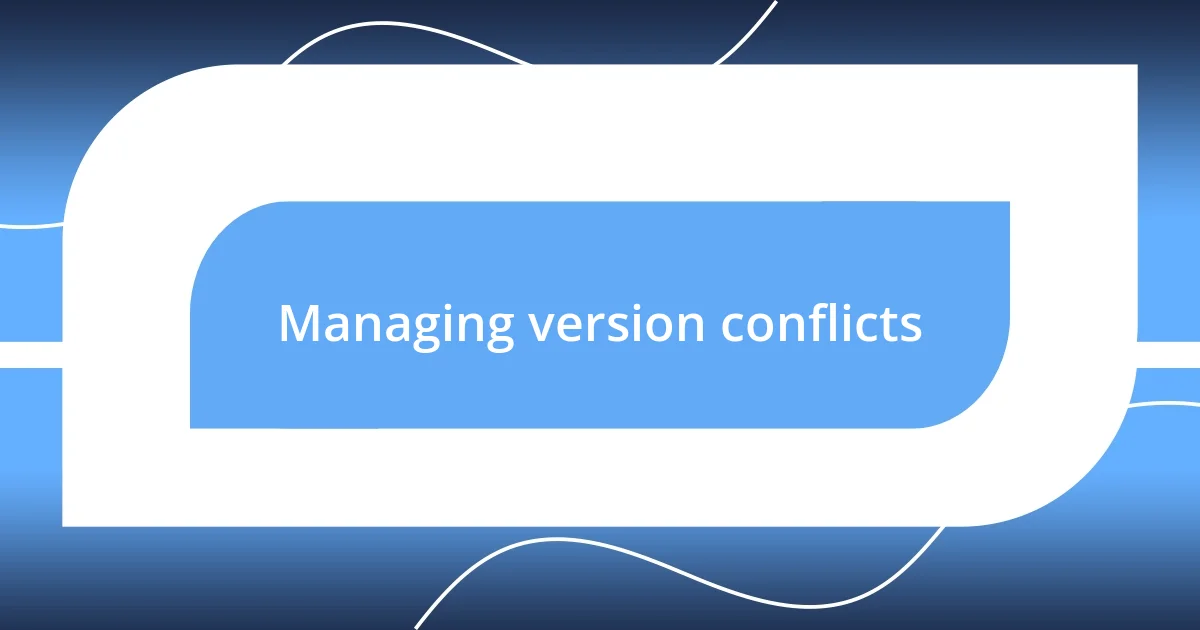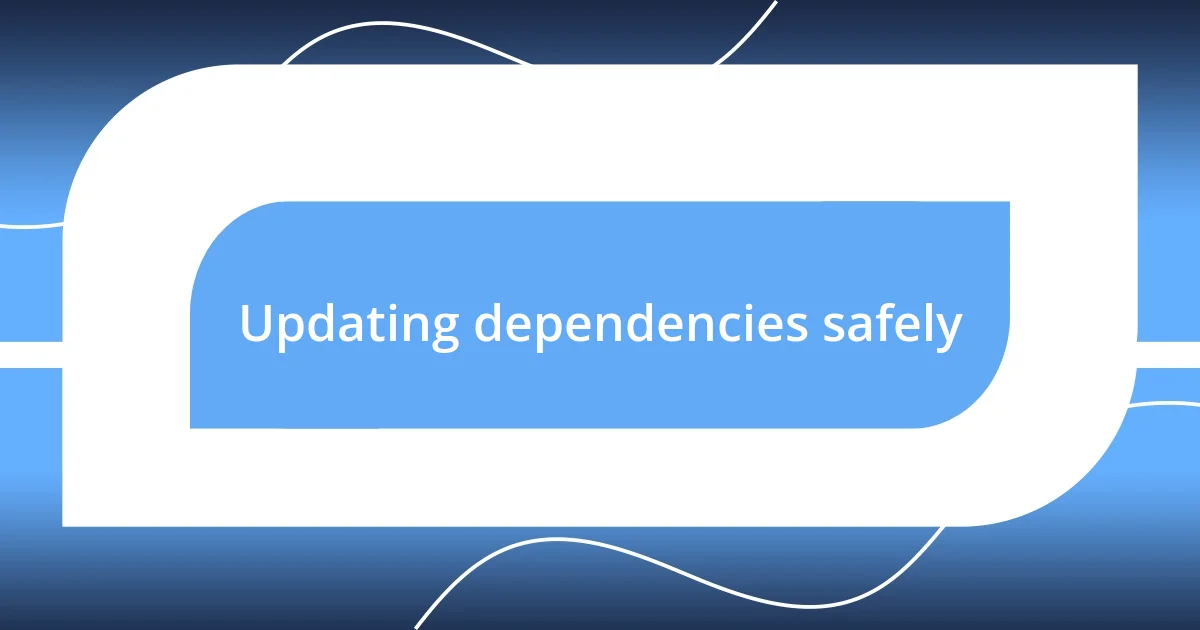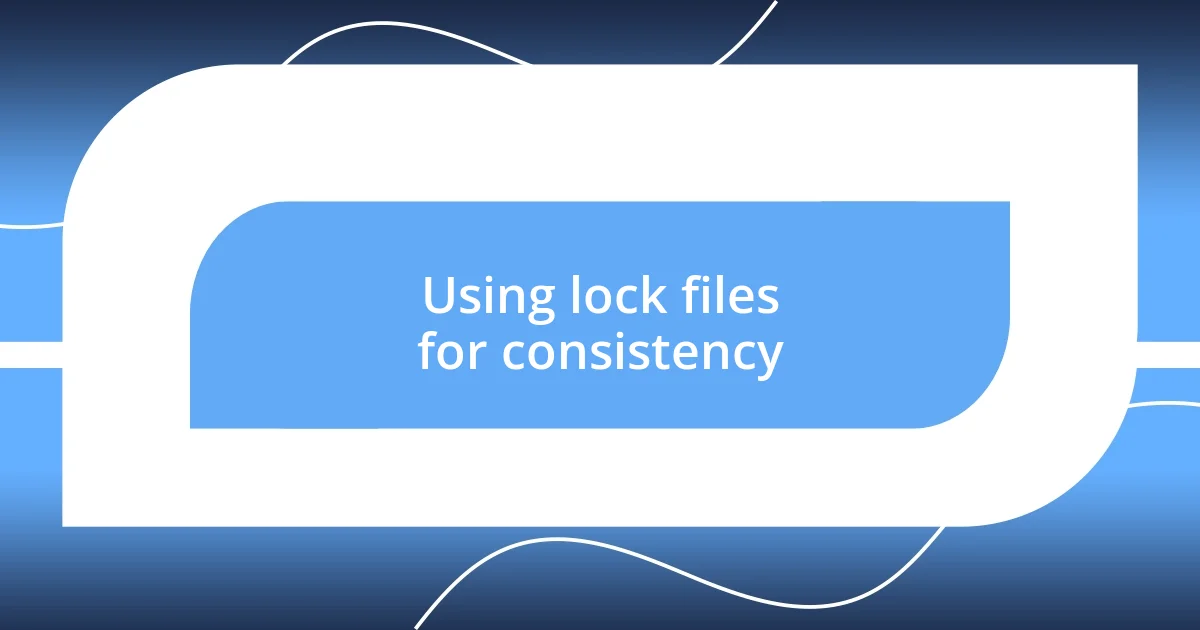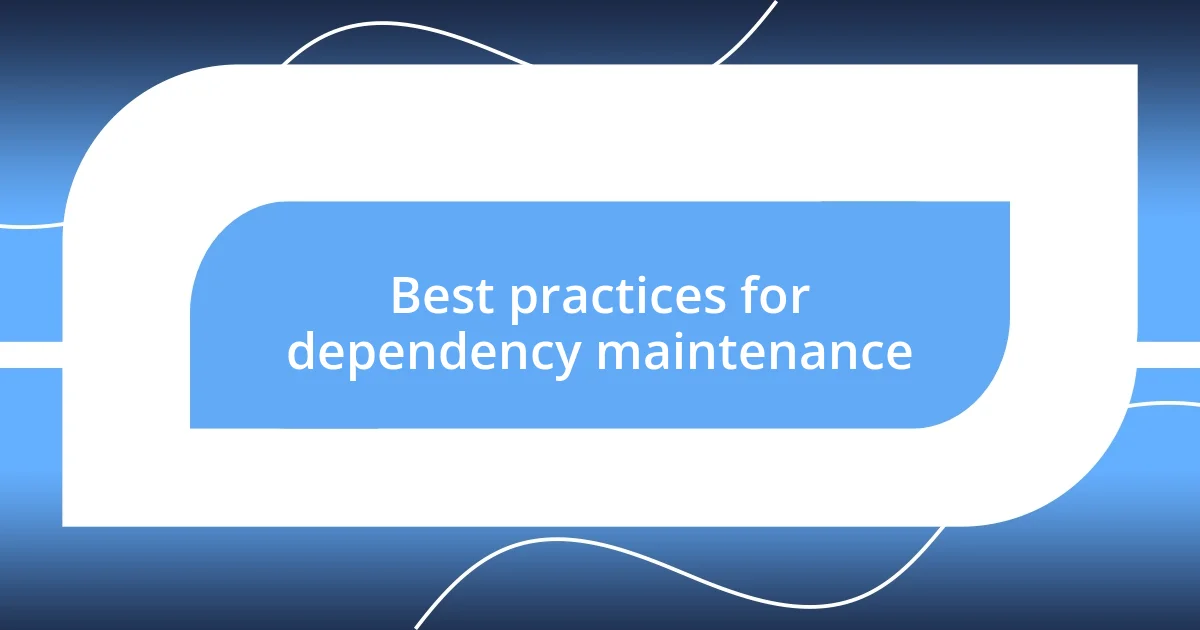Key takeaways:
- NPM dependencies are essential for JavaScript projects; understanding semantic versioning helps in managing conflicts effectively.
- Utilizing lock files like `package-lock.json` ensures consistency across environments and improves collaboration among team members.
- Regularly auditing and updating dependencies, alongside employing tools like Dependabot, enhances project security and performance.

Understanding NPM dependencies
NPM dependencies are the building blocks of your JavaScript projects, allowing you to tap into a vast ecosystem of libraries and tools. I still remember the first time I added a package to my project — it felt like unlocking a treasure chest of functionality. Suddenly, I could use established code without reinventing the wheel.
When you install a package, you’re not just grabbing code; you’re also agreeing to work with its dependencies, which are the other packages it requires to function properly. It’s kind of a web of relationships, and managing that web can be tricky. Have you ever faced a situation where multiple packages depend on different versions of the same library? It can quickly turn into a frustrating puzzle that I spent hours trying to solve.
Understanding semantic versioning, or semver, is crucial in navigating this maze. It dictates how version numbers of packages are assigned and allows you to predict changes that could impact your projects. When I first stumbled upon it, the concept seemed daunting. But grasping how to manage these versions has saved me countless headaches and ensured my projects remain stable.

Setting up your project
Setting up your project with NPM is a step that I always approach with a mix of excitement and trepidation. The first command I usually run is npm init, which creates a package.json file to keep all my project information organized. It feels like laying a solid foundation before constructing a house; without it, you could easily end up with a chaotic project.
Once I have my package.json file in place, I delve into adding dependencies. I vividly recall a project where I was tasked with building a small web app. The moment I typed npm install express, it was like a light bulb flicked on. This simple command pulled in the Express.js framework, setting me off on a productive journey. But here’s a tip: always check the dependencies included alongside your main package. It’s essential to know what else is being pulled into your project, as these can sometimes cause conflicts.
Managing dependencies isn’t just a matter of installation; it’s also about routine maintenance. I make it a habit to run npm outdated to check for any outdated packages regularly. This practice prevents surprises and keeps my projects aligned with the latest features and security updates. A little proactive management goes a long way in enhancing stability.
| Action | Command |
|---|---|
| Initialize Project | npm init |
| Install Dependency | npm install |
| Check for Outdated Packages | npm outdated |

Installing packages effectively
Installing packages efficiently is an art that I’ve honed over time. I remember the excitement of discovering the --save flag during a late-night coding session. It was like finding a secret passage that not only installed the package but also updated my package.json to reflect my newly added dependency. Such little efficiencies can make a big difference, especially when collaborating on projects.
When you install packages, consider these key practices to enhance your workflow:
- Use specific versions: Instead of installing the latest version, specify the version number to avoid unexpected breaking changes.
- Understand and utilize flags: Familiarize yourself with flags like
--save,--save-dev, and--globalto categorize your packages efficiently. - Audit your packages: Regularly run
npm auditto identify vulnerabilities and act before they become issues. - Leverage npx for one-time commands: This keeps your global namespace clean by allowing you to run CLI tools without installing them globally.
Each of these practices can streamline your package management and keep your projects both efficient and secure. It’s all about establishing a routine that not only saves time but also enhances project reliability.

Managing version conflicts
Managing version conflicts can feel like navigating a minefield, but with the right strategies, it becomes much more manageable. I remember a time when I encountered a conflict after updating a library, only to find that some of my existing code broke unexpectedly. It was a frustrating experience, but it taught me the importance of specifying exact versions in my package.json. By doing this, I can maintain stability and ensure each dependency plays nicely with the others.
One effective method I’ve found is to use the npm dedupe command. This command consolidates multiple versions of the same package in your project, which can drastically reduce the possibility of conflicts. I recall a project where running this command cleared up a tangled mess of dependencies, allowing my app to run smoothly again. It’s an easy fix, and I highly recommend incorporating it into your routine whenever you notice conflicting versions.
Moreover, taking time to explore tools like npm ls can really open your eyes to what’s happening behind the scenes. This command provides a tree-like structure of your dependencies, displaying which packages are causing conflicts. I encourage you to run it and see how it changes your perspective on dependency management. Have you ever wondered why a particular library is causing issues? By visualizing the relationships between your packages, you can pinpoint the culprits more effectively and make informed decisions.

Updating dependencies safely
Updating dependencies safely is a crucial aspect of maintaining a stable application. I used to be nervous about updating packages, fearing that new versions would wreak havoc on my project. However, I’ve learned that the npm update command can be both a friend and a foe. It allows you to upgrade dependencies while retaining flexibility by updating them within defined version ranges, which can prevent unexpected changes from breaking your code.
During my development journey, I often take a moment to create a backup or branch before major updates. For example, I once faced a significant challenge after an update, when a vital feature unexpectedly broke. By having a backup, I could easily revert to the previous state and carefully analyze what went wrong. Have you ever had to backtrack after an update? It’s a sound practice that saved me countless headaches and ensured my project’s integrity.
Moreover, I recommend using the npm outdated command regularly. I remember a project where I ran it on a whim and discovered several dependencies lagging behind. This simple action not only kept my project secure but also encouraged me to stay proactive rather than reactive. Nothing beats the feeling of knowing I’m keeping my codebase healthy and reducing potential risks before they become urgent problems. What strategies do you use to ensure your updates are safe? Sharing these experiences can help us all grow in our dependency management skills.

Using lock files for consistency
Using lock files is a game changer when it comes to ensuring consistency across different environments. I remember launching a project and finding that everything ran smoothly on my local machine, only to be met with a confusing array of errors in the production environment. That’s when I turned to package-lock.json. By locking down the exact versions of my dependencies, I managed to alleviate the discrepancies that were once a constant source of frustration. Have you ever deployed code only to wonder why it behaves differently in production? It’s a classic scenario that can be mitigated with the right use of lock files.
Another aspect I appreciate about using lock files is how they aid collaboration within teams. During a recent project, we experienced a situation where multiple developers were working on the same codebase and inadvertently installed different versions of a package. This caused confusion and wasted time. However, by relying on package-lock.json, we ensured that everyone was aligned, effectively eliminating the guesswork. It’s empowering to know that by simply committing this file to version control, we’re all on the same page. How do you approach collaboration in your projects? Consider how lock files might streamline your workflow.
In my experience, using lock files not only helps with consistency but also enhances security. I’ve seen firsthand how outdated dependencies could introduce vulnerabilities. Combining npm shrinkwrap or npm ci with the lock file means installing the same dependencies every time, which minimizes the chances of unknowingly using a less secure version. Just the other day, I read about a vulnerability in a widely used package, which confirmed my belief that consistency directly ties into security. Are you making the most out of your lock files to safeguard your projects? Trust me, it can make a significant difference in maintaining the integrity of your application.

Best practices for dependency maintenance
Maintaining a clean dependency tree is a vital best practice that I cannot stress enough. I recall a challenging project where my dependencies grew so unwieldy that managing them became a nightmare. By regularly reviewing and removing unused packages, I not only streamlined my codebase but also enhanced performance. It’s amazing how often we hold onto packages we no longer need—what about you? Have you taken the time to audit your dependencies lately?
Another strategy I’ve adopted involves adhering to semantic versioning. I remember the first time I ventured into updating a major dependency without checking for breaking changes. It resulted in an utterly chaotic build and an urgent late-night debugging session. Now, I scrutinize the changelogs for major updates, and I make it a point to update in a controlled environment to minimize disruptions. Do you feel equipped to handle major version updates? A little due diligence goes a long way in preventing headaches down the line.
Additionally, I find setting up automated notifications for dependency updates incredibly helpful. In a recent experience with a critical project, I leveraged tools like Dependabot to alert me of updates. It felt like having an extra pair of eyes monitoring my dependencies! This not only kept my project secure but also reminded me to check for new features that could enhance my workflow. How do you plan your update strategy? I’ve learned that being proactive rather than reactive significantly contributes to a smoother development process.














